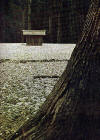Great Shinto Shrine at Ise
(Japan)
Trees and stones have
long been objects of deep devotion in Japan. Originally there were
no shrine buildings; instead a tree, forest, or a large boulder or a
mountain, festooned with ropes, would be the focus of worship.
In Japan the mysterious forces of nature, called ke,
were believed to permeate palpable matter and formless space
(collectively called mono in Japanese) to create mononoke.
Mononoke was seen to coalesce in trees and stones.
Certain trees, especially the cryptomeria and the evergreen
sakaki, were considered sacred for this reason. When one of
these trees was felled and the wood used in the construction of a
shrine, this sacred quality was believed to follow it into the
building. The sacred tree itself was literally and symbolically
present in the form of a pillar or post around which the shrine was
constructed.
The great Shinto shrine at Ise is built amid a dense
forest of giant cryptomeria trees next to the Isuzu River at
the foot of Mount Kamiji and Mount Shimaji in the Mie Prefecture in
southern Honshu, Japan. Crossing the Uji Bridge and passing through
the large torii gate marking the entrance to the shrine, a
long path leads to Ise Jingu (Ise Grand Shrine).
The shrine consists of two groups of buildings: the Imperial
Shrine (Kotai Jingu), also known as the Naiku
(inner shrine), and the Toyouke Shrine (Toyouke
Daijingu ) which constitutes the Geku or outer
shrine. The Naiku is dedicated to the Sun
Goddess Amaterasu Omikami (Heaven-Illuminating Great Deity),
and the Geku to the Goddess of Cereals Toyouke
Omikami (Abundant Food Great Deity). Each shrine is composed
of a number of buildings, including ancillary shrines, workshops,
storehouses, etc. Each shrine has an inner precinct with a main
sanctuary and two attendant shrines, as well as treasuries, fences,
and gates.
Both shrines are constructed of wood, and every twenty years both
are totally rebuilt on an adjoining site. The empty site of the
previous shrine (called the kodenchi) is strewn with large
white pebbles. The only building on the empty site, which retains
its sacredness for the intervening twenty years, is a small wooden
shed or hut (oi-ya) inside of which is a post about seven
feet high known as shin-no-mihashira (literally the
august column of the heart, or more freely translated as sacred
central post). The new shrine will be erected over and around this
post which are the holiest and most mysterious objects in the
Ise Shrine. They remain hidden at all times.
|
|
The oi-ya in the old shrine compound of the Naiku |
The Grand Shrines of Ise
|
"click" on images to enlarge
Kenzo Tange and
Noboru
Kawazoe suggest that:
The erection of a single post in the center of a sacred area strewn with stones represents the form taken by Japanese places of worship in very ancient times; the shin-no-mihashira would thus be the survival of a symbolism from a very primitive symbolism to the present day.
The present buildings
reproduce the temple first ceremoniously rebuilt in 692 CE by
Empress Jito. The first temple had been built by her husband
Emperor Temmu (678-686), the first Mikado to rule
over a united Japan. Emperor Temmu had established Ise
as the principal cult shrine of Imperial Japan, but the site itself,
and the cryptomeria trees that grew on it, were already
sacred before then. The cryptomeria is a tree associated with
Shinto shrines. The principal sacred plant of Shinto,
however, is the sakaki (a shrub related to the tea bush). The
shin-no-mihashira is taken to represent a branch of the
sakaki stuck upright in the ground.
The chambers of the shrines are raised on timber piles which
themselves are analogous to the central sacred post. The roof is not
supported by the walls (although the rafters do rest on purlings),
but the ridge beam is carried instead by two large columns at either
end which embedded directly into the ground without any foundation.
Besides trees, at the Ise Shrine are many subsidiary
shrines of rocks from the sea which are regarded as the abodes (iwakura
or rock abodes) of deities.


